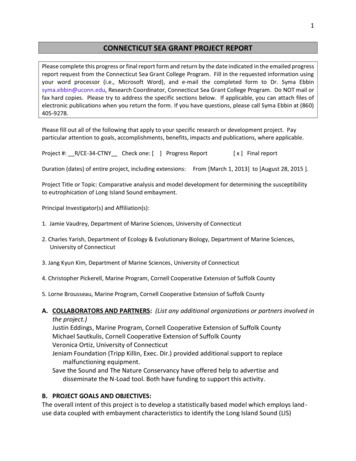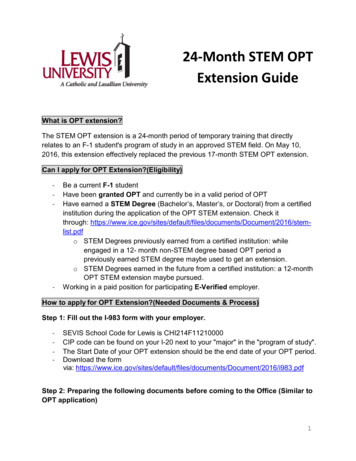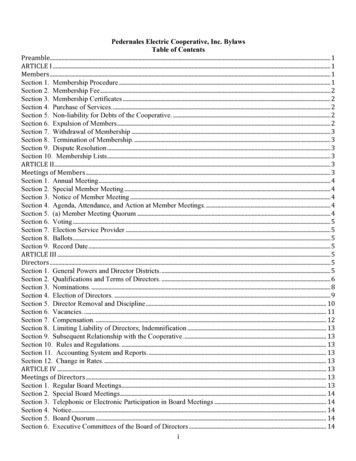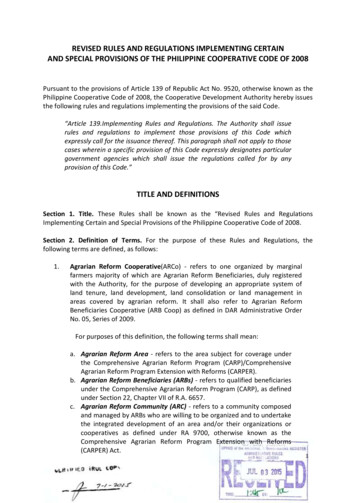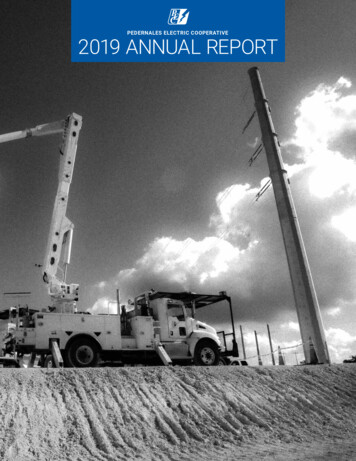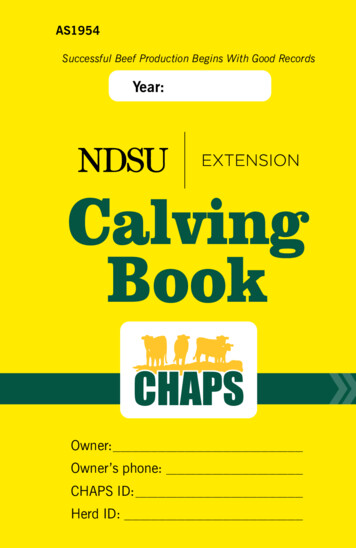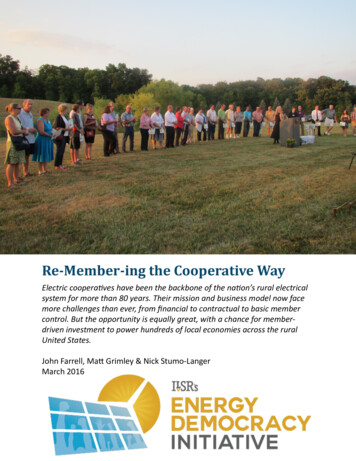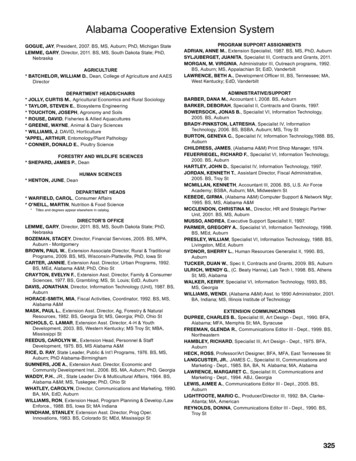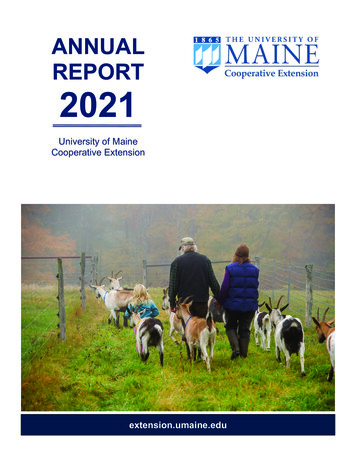
Transcription
ANNUALREPORT2021University of MaineCooperative Extensionextension.umaine.edu
Photographs of people not wearing masks were taken prior to the coronavirus pandemic. The University of Maine,University of Maine at Machias, and University of Maine Cooperative Extension follow federal and state Centers forDisease Control and Prevention health and safety guidance, which currently includes social distancing and use of facecoverings.The University of Maine is an EEO/AA employer, and does not discriminate on the grounds of race, color, religion, sex,sexual orientation, transgender status, gender expression, national origin, citizenship status, age, disability, geneticinformation or veteran’s status in employment, education, and all other programs and activities. The following person hasbeen designated to handle inquiries regarding non-discrimination policies: Director of Equal Opportunity, 101 NorthStevens Hall, University of Maine, Orono, ME 04469-5754, 207.581.1226, TTY 711 (Maine Relay System). 2022
2021 Annual ReportOur Mission: Putting university research to work inhomes, businesses, farms, and communities forover 100 years.University of Maine Cooperative Extension’s 2021 Digital Presence1Maine Food System24-H Positive Youth Development8Sustainable Community and Economic Development14Financial Support18Office of the DeanWelcome to the University of Maine Cooperative Extension! We are located acrossthe state in 16 county offices, research farms, 4-H camps and learning centers, andonline. We are the largest outreach component of the University of Maine andreach more Maine people than any other entity within the seven campus Universityof Maine System. Our work is focused on helping Maine communities thrive and wedo so by connecting people to research-based information, education and services.UMaine Cooperative Extension conducts the state’s most successful out-of-schoolyouth education program through4-H, empowering young people to reach their full potential. Our youth programmingalso includes our 4-H camps and learning centers which provide opportunities foryouth to engage in outdoor experiential learning. Extension also helps support,sustain, and grow the food-based economy across the entire state of Maine. Inaddition, we provide valuable statewide programming in nutrition education, healthyfamilies and communities and within the aquaculture industry. We also partner withother organizations and programs to provide additional educational opportunities to a diversity of audiencesacross this state.Extension faculty and staff across the state have also contributed to significant digital outreach this past year.Our Extension website (extension.umaine.edu), which is a combination of 57 interconnected websites,received 3.1 million views in 2021. We have over 700 research-based publications that are available as freedownloads at extension.umaine.edu/publications. And in this past year, we had more than 5,000 customersregister for workshops, events, webinars and more through our online registration system.UMaine Cooperative Extension is determined to make a positive difference in our areas of excellence andbeyond for the citizens of Maine. Explore our website, visit a county office, and contact our enthusiasticworkforce.— Hannah Carter, Dean
University of Maine Cooperative Extension’s2021 Digital PresenceWebsiteUniversity of Maine Cooperative Extension’s website at extension.umaine.edu – a combination of 57interconnected websites consisting of nearly 12,000 pages – received 3.1 million pageviews fromvisitors in the 12 months between January 1, 2021 and December 31, 2021. Visitors searched for andfound information on a wide variety of topics, including planting in Maine, small business management,harvest and storage of tree fruits, tussock moth caterpillar identification, and tractor safety. Imagegalleries helped users identify pests, plant diseases, and weeds. A wide variety of interactive web formsallowed users to request assistance, presentations, newsletters, and updates; report volunteer hours;make donations; and respond to surveys. Nearly 65,000 web visits were referred from social media,more than nine times the previous year.Social MediaMore than 45,000 followers followed or were subscribed to UMaine Extension’s 62 county andprogram-specific social media accounts on Facebook, Twitter, YouTube, Pinterest, Instagram, andTikTok. Nearly 600 educational videos were available to visitors on our 14 YouTube playlists; manywere also embedded in our web pages. Extension’s YouTube videos were the most watched on theUniversity of Maine Channel, which received 1.4 million views and 70,000 hours of watch time. Topvideos included Lobster Cooking and Eating, How to Prune a Blueberry Bush, How Do I PruneRaspberries, Tick Removal, How to Prune a Lilac Bush, and How to Seal Windows for Winter andSummer.PublicationsMore than 700 research-based publications on a broad range of topics were available for free downloadat extension.umaine.edu/publications. Our most popular fact sheets received tens of thousands ofpageviews each. New publications in 2021 included Tips for Growing Houseplants in Maine, UsingChecklists to Increase Productivity on the Farm, Best Practices for Plant Sale Donors and Buyers inMaine, Too Much Water or Not Enough Light? Irregular Growth Commonly Seen on Plants GrownIndoors, and How to Cut Up a Whole Chicken.Online Registration, Brightspace, and MailChimpNearly 5,000 customers registered for workshops, events, webinars, and more through our onlineregistration system.Nearly 200 participants took online courses via Brightspace. Classes included Master GardenerVolunteer training, a Home Horticulture class, and a 4-H Aquaculture course.More than 9,500 subscribers received a total of 53,880 e-notifications via MailChimp.1
Maine Food SystemIntegrated Pest Management for Maine Potatoes and Fruit TreesThe University of Maine Cooperative Extension Diagnostic Research Laboratoryprovides pest identification and integrated pest management education to commercialand home clients. The 500 million potato industry is the largest agricultural sector in Maine,encompassing more than 500 businesses generating more than 300 million in annual sales, employingover 2,600 people, and providing over 112 million in income to Maine citizens. In 2020 the Extension’sIPM research and identification efforts saved Maine’s potato industry an estimated 10 million in lossesavoided, yield increases and reduced pesticide use; for an expenditure of 95,000, the return was 110 to1. And our IPM program saved Maine’s fruit tree industry over 5.1 million in losses avoided, and over 1.1 million savings in pesticide savings in purchase costs.Extension Shares PFAS Resources for FarmersRelevance — Low levels of PFOS, PFOA and other PFAS are present in our environment. Higher levelsare sometimes found near airfields that may have used fire-fighting foams, factories that used thesechemicals, or land with a history of using certain waste materials or biosolids containing PFOS, PFOA, orother PFAS. Crops may be grown on soil that has these PFAS, but how much of these chemicals are inthe crop depends on the type of crop, what part of the crop is edible, soil properties, and levels in the soil.These chemicals may end up in the milk and meat of animals fed crops like hay containing PFAS. Thesechemicals can also move from the soil into the groundwater and into well water. Consuming contaminatedmilk, meat, plants, or water are potential ways people can be exposed to these chemicals. The state ofMaine has allocated significant funding for dealing with issues related to PFAS and is dedicated tosupporting the landowners who are affected by land application of wastewater sludge and septage, AFFF,Department of Defense sites, landfills or other PFAS sources.Response — UMaine Extension has made a dynamic set of resources about on-farm PFAScontamination available online to the public in one location: ting-pfas-risk-on-your-farm/. “Guide to Investigating PFAS Risk on Your Farm” is acomprehensive collection of resources about contamination from Per- and Polyfluoroalkyl Substances inMaine. Topics include Maine’s response to contamination at agricultural sites, steps to determining risksand mitigation options for farms, and information on the sources of PFAS contamination. The newwebsite will be updated as the research and resulting information evolves. The resources are frommultiple Maine state agencies, including the Departments of Agriculture, Conservation and Forestry,Health and Human Services, Environmental Protection, and Maine CDC. Supporting organizationscontributing information include UMaine Extension, Maine Farmland Trust and Maine Organic Farmersand Gardeners Association.2
Farm and Ranch Stress Assistance Network (FRSAN)Relevance — Mental health is an often-overlooked challenge farmers face nationwide. Farmland lossand land access issues, rising production costs, plummeting farm incomes, climate change, and, mostrecently, the pandemic are contributing to a mental health crisis within the farming community. Suiciderates amongst farmers and ranchers are well above the national average while mental health services areless available and accessible in rural areas.Response — In the 2018 Farm Bill, the Farm and Ranch Stress Assistance Network (FRSAN) wasestablished to support farmers, ranchers, and other agricultural workers with stress management andoffers a pathway for improving mental health awareness and access for farmers and their families. NIFAawarded funds to four regional entities to help launch the network. The Northeast funds ( 4.8 milliondollars) were granted to the National Young Farmers Coalition, with subcontracts to Farm Aid, VermontFarm First, UMaine Cooperative Extension, Northeast Farmers of Color Land Trust, and MigrantClinicians Network to assist with advising the direction of the project and bringing together of Networkmembers. In 2021 Extension led this collaboration in a successful 500,000 grant proposal with theaward being used as directly as possible to serve farmers.Results — In 2021 there were 243 members in the FRSAN-Northeast Network. The Network held 14trainings, distributed 349,000 Cohort Grant funds and 40% of the funds were allocated to Black,Indigenous, and People of Color (BIPOC) led projects.Building Service Provider Capacity in Climate Adaptation PracticesRelevance — Current and projected changes in weather present new opportunities and risks for Maineagriculture, such as longer growing seasons but increased risks of spring frosts, summer droughts, andmore frequent and intense rainfall. In many cases, the climate adaptation practices that farmers andagricultural service providers have identified as helpful (e.g. irrigation and weather-based decisionsupport tools) require new knowledge and skills, not just for the farmer but also for their service providers,such as Extension, NRCS, conservation districts, state agencies, private crop services, and non-profitorganizations.Response — During the winter of 2021, we conducted a Northeast SARE funded, comprehensive needsassessment of agricultural service providers who work directly with farmers to identify their knowledgegaps and training needs as related to helping farmers adapt to climate change. Across the Northeast, 381completed an online survey, including 61 who said they work in Maine. Eleven Maine providers alsoparticipated in a related focus group.Results — Eighty percent of the respondents who work in Maine said they are interested in helpingfarmers address climate change but only about half said they currently have the needed knowledge,skills, and confidence. Drought, extreme precipitation events, and changes in water availability were ratedas severe or major climate change risks by 70% of respondents. Respondents reported being leastconfident in providing recommendations to farmers about investing in irrigation and water sourcedevelopment; ditching, water diversion, drainage tiles, and other ways to address too much water; andusing weather-based decision tools. Among these Maine respondents, 83% said they would be likely orextremely likely to participate in professional development opportunities to improve their ability to helpfarmers adapt to climate change. Results from these studies were used to develop a 3-year SAREprofessional development program to build provider capacity in Maine in climate adaptation practices.3
So, You Want to Farm in Maine?Relevance — Current farmers thinking about changing farm enterprises and new farmers interested instarting a farm may lack the skill, knowledge and confidence to investigate their options to start, adapt,and maintain a profitable land-based business. Major issues farmers and potential farmers (whether fulltime or part-time) need to overcome include access to capital, understanding of rules and regulationsaffecting agriculture operations, and marketing options.Response — UMaine Extension created the So, You Want to Farm in Maine short-course in 2015.Traditionally offered in person, this is the third year it is available online only. It is designed to introducefarm business management topics to those who are starting farms in Maine. The 2021 session was a bitdifferent as participants include 44 aspiring farmers as well as 11 UMaine undergraduates, providing theopportunity for richer discussions and connections between those interested in starting Maine farmsimminently, as well as students with a variety of backgrounds and experience. The undergraduates areteamed with aspiring farmers to create draft business plans over the course of five weeks. Farmers havethe opportunity to receive USDA Farm Service Agency borrower training credit, and undergraduatesreceive one credit.Since 2015, 292 people have participated through face-to-face, video-linked, webinar, live-streamed,Zoom, and archived sessions to learn about agriculture enterprise selection, business planning, recordkeeping, market research, regulations, and resource identification.Results — Knowledge change was assessed by a post program evaluation. Participants responding to aprogram evaluation reported having moderate to considerable knowledge and understanding of thefollowing topics following the program: Goal setting and farm business management plan development;enterprise budget development and evaluating profitability; land and asset assessment; marketing andmarketing research; recordkeeping (production and financial); estate planning and insurance; permits,licenses, and regulations; Credible sources of production information and pricing; taxes (local, state andfederal); financial management. Successful completion of this course qualifies participants for FSABorrower Training Credit; In 2021, participants who chose to get the FSA certification included enterprisebudgets totaling over 139,000 in projected income.University of Maine Veterinary Diagnostic Laboratory (VDL)Relevance — During 2021, the University of Maine Veterinary Diagnostic Laboratory (VDL) stayed open,providing service to farmers and veterinarians as requested.Response — We allowed egg producers in Maine to keep marketing their product by providing FDArequired screening for Salmonella enteritidis (SE) on midsize to large egg farms. We helped dairies findout whether their cows were affected by mastitis, and if so, what “bugs” were responsible. We helpedhorse, sheep, goat and cattle owners check to see if their animals need worming, and if so, with what kindof product; we also helped them find out if their chosen product actually worked in their animals. Wehelped the state animal welfare vets discover whether animals had died due to neglect or cruelty byproviding fact-based forensic information via conducting necropsies.Results — Four undergraduate students were employed by the VDL during this time, and were trainedand mentored in a socially-distanced environment. We have helped our staff and clients comply withrestrictions imposed by the pandemic, and used creative strategies to keep our productivity within normallimits, at the same time as offering new services. While the COVID-19 pandemic changed the manner inwhich we operated, we remained open and active continuously during 2021 and 105 necropsies of manyspecies of animal, from woodchuck to horses, were conducted in the new UM VDL necropsy room. Wewere able to host a virtual REU program during summer 2021, and planned an in-person summerprogram.4
Our diagnostic lab assists UMaine academic researchers by assisting with sample preparation forhistologic studies, by collaborating on studies where pathology assistance is needed (including a patentfor a biomedical device), and by providing microbiological testing in a new study of multi-drug resistantStaphylococcus aureus (MRSA). We are collaborating with other animal science faculty and with theMaine Department of Inland Fisheries and Wildlife (IFW) on studies of moose health, and areinvestigating methods for reducing the risk of meningeal worm (Parelaphostrongylus tenuis) transmissionfrom white tailed deer to domestic ruminants.Our lab hires a small number of student workers of diverse backgrounds, who benefit the lab by providingenergetic, curious and detail-oriented efforts. These students help us adapt our methods to develop betterteaching and outreach materials for farmers, at the same time as they develop skills and knowledge thatwill help them in their veterinary careers. Our lab combines service, research and education to improveagriculture, the food system, and the quality of life in Maine.Diagnostic and Research Laboratory Brings Many Scientists and SpecialtiesTogether Under One RoofThe University of Maine Cooperative Extension Diagnostic and Research Laboratory occupies a 28,000square-foot commercial laboratory building located a few miles from campus, and houses our VeterinaryDiagnostic Lab, Aquatic Animal Health Lab, Arthropod Lab, and Plant Disease Diagnostic Laboratory.This facility is the most bio-secure location within the UMaine System. Opened in 2018, the lab bringstogether scientists researching animals, agriculture, insects, and plants under one roof. The uniquecombination of researchers provides many teaching opportunities for students, as well as premierresearch and outreach facilities. By allowing for research contributions to agriculture, public health,communities, and wildlife, the lab benefits Maine in a variety of ways, including protecting the naturalresource- and food-based economies, adding to food safety and human health, and providing uniquediagnostic and testing services to farmers, homeowners and the public.Process Validation to Seafood ProcessorsRelevance — In order to meet FDA seafood regulations, food processors must thermally process theirproduct correctly to ensure regulatory compliance and safe food production; this includes all cookedready-to-eat seafood products. Most processors do not have employees that can provide these validationreviews and there are a limited number of process authorities that can provide these services.Response — In 2021, 106 clients (64 from Maine) submitted 410 food products (264 from Maine) fortesting that included a total of 873 tests. Extension created individualized reports on all products.Results — The testing lab had a 37% increase in products over 2020. One co-packer in Maine submitted62 products and 178 tests to support Maine and out-of-state clients to produce their food products. ThisMaine co-packer said Extension was able to assist them to comply with FDA requirements and thatExtension’s support helped them secure 500,000 worth of new client business in 2020. The co-packernoted Extension’s knowledge of FDA regulations and ingredients demonstration of a true partnership tohelp develop and grow new clients from Maine and all over the country.Recipe to Market Program: Growing Successful Food Entrepreneurs in MaineRelevance — There has been a growing interest in value-added food production in Maine. From farmerslooking to add value to their raw products, to Maine families interested in turning their favorite recipes intoviable food businesses. In response to this growing demand, UMaine Extension developed the Recipe toMarket program in 2007 and has been offering it to statewide audiences annually ever since. The goal ofthe program is to help potential and existing food entrepreneurs acquire food science and businessknowledge and skills to successfully bring a value-added food product to market.5
Response — Since 2007, Extension has conducted 36 programs in 10 counties reaching 480participants across the state. The program is offered in either single or multi-day formats, in person orvirtually, and is designed to help participants understand licensing/regulations, processing/packaging, thespecialty food industry and acquire business management knowledge and skills. The RTM team providedsimilar content for the Wild Blueberry Conference winter/spring 2021 and was able to reach additionalparticipants statewide. The RTM Team also supported food businesses during the pandemic by offering apanel session at the Maine Ag Trades Show via Zoom titled “Pivoting During the Pandemic – How Foodand Beverage Businesses Creatively Thrived in 2020.” The team invited 4 small businesses to discussthe impacts of the pandemic on their businesses and how they creatively pivoted to stay in business andto thrive during the pandemic. These businesses ranged from a brewery in Ellsworth, to a value-addedproducts/blueberry farm in Ornesville Township to a cheesemaking business in Whitefield, that alsocreated a new distribution business to support their fellow cheesemakers.Results — As a result of these programs, more than 90% of participants said they improved theirknowledge and skills and plan to adopt business and food processing/safety practices they learned duringthe program. Long-term survey results indicate that participants used the new knowledge from RTM tomake more effective business decisions, develop new food products, and write and revise business andmarketing plans. The survey results also indicate that 27% of the RTM multi-session participantssubsequently started food businesses. We estimate that 60 new value-added food businesses,generating 2.1 million in direct sales and employing 102 workers were started in Maine by the 221people attending our Recipe to Market multi-session programs since 2007.Home HorticultureRelevance — Every day, Maine gardeners are deciding on whether and how to manage pests, whatfertilizers to use and how much, what plants to grow, methods to cultivate the soil, and how to utilizewater resources to maintain landscapes. Nearly every residential site has a landscape that requiresmaintenance and decisions made in these sites can have a significant impact on our natural resources.Home gardener success also results in improved food security and has an economic role in our greenindustry.Response — In 2021, home horticulture programming directly reached 12,256 adults and 896 youththrough over 120 hours of educational programs, both in-person and virtual. This included over 5,223questions, received via email, phone calls and walk-ins that were answered for home gardeners. Anadditional 14,579 home gardeners were reached indirectly through garden-related videos, newsletters,newspaper columns, and publications from Extension.Results — As a result of Extension programs, participants reported developing new or expandingexisting gardens; increased their consumption of home-grown food; adopted sustainable gardeningpractices involving soil quality, improving efficiency, and adopting IPM strategies; and using Extension toidentify pest problems and to determine research-based management strategies.Maine Food and Agriculture Center Supports State’s Growing IndustriesRelevance — The MFAC is a partnership of Extension and the Maine Agricultural and ForestryExperiment Station.Response — The center utilizes the 16-county reach of Extension, and many of Extension'srecommendations to the state's agricultural community come directly from research conducted atExperiment Station farms. This research-extension partnership has been working for over 100 years andis as vital today as it was early in the 20th century.Results — With 5 billion in overall economic impact, agriculture, commercial fishing, and foodprocessing include Maine's largest, fastest growing, and most promising industries. MFAC is growing toencompass all sectors of the burgeoning food economy, establish first-contact access to the programs6
and expertise available at all seven of Maine's public universities, and create opportunities for crosscampus and cross-discipline coordination and program development based on emerging needs inMaine's food economy.Maine Agricultural Mediation Program (MAMP) Saves Money, Properties, andRelationshipsRelevance — Resolving disputes through administrative appeals or litigation is costly, time-consuming,and stressful for everyone involved. It can take years for a case to filter through the courts, the impact ona farm or family can be devastating, and costs can multiply across local and state agencies. By contrast,mediation generally resolves disputes with only a few meetings, providing a low-cost alternative toappeals or often expensive litigation and bankruptcy. Each case that is resolved through mediation savestime, attorney and court fees, travel, and the family’s mental and physical well-being.Response — Extension is home to the Maine Agricultural Mediation Program (MAMP), part of the USDAAgricultural Mediation Program. The MAMP provides alternative dispute resolution through mediation tofarmers, their lenders, and others directly affected by the actions of certain USDA agencies; in neighbordisputes; and in workplace and family disagreements that affect the farm. Mediation is voluntary andconfidential, and involves a trained, impartial mediator helping participants to resolve disagreements. In2020, the MAMP held 19 mediations and provided coaching to 4 farms. All cases were resolved withoutneeding to progress to the courts.Results — The Farm Service Agency estimates the typical cost savings for a simple adverse decisioncase is 10,000, and as much as 40,000 can be spent on cases that extend over years. In addition tosavings in staff time, savings to producers and/or participants includes preservation of assets, properties,and relationships. In 2020, the MAMP estimates that as much as 300,000 was saved throughagricultural mediation in Maine.7
4-H POSITIVE Youth Development4-H Ambassadors Spark Student Interest in STEM CareersRelevance — Developing Maine youth’s STEM literacy is vital to ensuring that our state continues tothrive economically and socially. Given the remote and diverse communities where Maine youth live,informal education can help minimize inequities in rural youth STEM education and career pipelines.Future career opportunities in Maine will depend heavily on STEM skills, whether in the growing fields ofhealthcare and engineering, or in positions requiring technical skills, such as construction, andmaintenance of transportation and energy systems.Response — Since 2014, Extension’s 4-H STEM Ambassadors program has enrolled and trained morethan 500 UMaine System students who have facilitated in-person, hands-on learning experiencesfostering youth STEM enjoyment, literacy, and identity, reaching more than 6,000 Maine youth aged 8-14in classrooms, libraries, and afterschool clubs across the state. In Fall of 2020, to meet university andcommunity COVID guidelines, Extension redesigned the program to be virtual, including a training,mentoring, and experiential STEM programming.Results — The shift to a virtual program allowed for multi-campus student teams and increased accessfor more distal community partners regardless of local program model (remote, in-person, hybrid). In2020, the 4-H Stem Ambassadors program reached more than 200 students, grades 3-8, across 11 siteswith the help of 34 volunteer Ambassadors and 4-H staff facilitators. And in 2021 the program reachedmore than 300 students, grade 3-8, across 18 sites with the help of 39 volunteer Ambassadors and staff.Through this program, youth ages 8-14 come to view these Ambassadors as mentors and leaders in theircommunity while also developing skills in STEM through hands-on activities, and becoming connected toresearch, resources, and scientists at Maine’s public universities.Summer of ScienceRelevance — Research shows that low-income students have less than average access to scienceeducation, and a STEM achievement gap is perpetuated during summer months for low-income students,who lose more grade equivalency due to lack of out-of-school and summer learning opportunities. Anincrease in STEM education can lead to better employment opportunities and increase the likelihood ofyouth furthering their education. Summer of Science seeks to improve student proficiency in STEM,introduce them to STEM careers, and support low-income students in an effort to decrease summerlearning loss. SOS is unique in utilizing Teen Teachers - often a first paid position for high schoolstudents. Partnering with other youth organizations, interns and teen teachers lead activities for youth ingrades 3-6. Teens and interns gain skills in career development, time management, leadership, publicspeaking, and group work.8
Response — UMaine Extension created the 4-H Summer of Science program to increase scienceproficiencies in local communities and prevent summer learning loss by providing informal hands-onexperiential learning opportunities in STEM to Maine youth and engaging Maine youth in low-incomeareas in meaningful experiential STEM activities. Maine 4-H staff and Summer of Science college internsdeveloped and modified four sci
Farm First, UMaine Cooperative Extension, Northeast Farmers of Color Land Trust, and Migrant Clinicians Network to assist with advising the direction of the project and bringing together of Network members. In 2021 Extension led this collaboration in a successful 500,000 grant proposal with the

